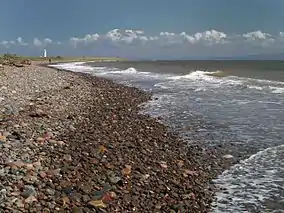| South Walney | |
|---|---|
IUCN category IV (habitat/species management area) | |
 The shingle beach on the seaward side of the reserve photographed in 2009 | |
| Location | Cumbria, United Kingdom |
| Area | 130 ha |
South Walney is one of two nature reserves on Walney Island, England. The nature reserve has an area of 130 ha leased from Holker estates. It has been managed by the Cumbria Wildlife Trust since 1963.[1] The reserve is notable for:
- Gulls. There are lesser black backed gulls and herring gulls.[2] Numbers have declined considerably since the 1970s.[3]
- Among the reasons for the decline has been predation. In 2021 Cumbria Wildlife Trust reported that a predator-proof fence had protected chicks at the reserve.[4]
- Seals. It is the only grey seal colony in Cumbria.[5] Numbers have increased since the 1970s. Until recently South Walney was classed as a haul-out site rather than a breeding colony, but two pups were born there in 2015,[6][7] and five the following year.
The reserve is the home of the Walney Bird Observatory which collates bird records from across the island. Around 300 species of bird have been recorded on Walney Island since the foundation of the bird observatory in 1964.[8]
Facilities
South Walney Nature Reserve is open daily 10am to 5pm (4pm in winter). The road to the reserve can be affected by high tides. There are bird hides. A seal webcam went live in 2016.[9]
Protection
Sites of Special Scientific Interest
South Walney and Piel Channel Flats are designated a Site of Special Scientific Interest for biological and geological interest. The SSSI includes the South Walney part of the Walney Island Geological Conservation Review Site. The SSSI is contiguous with two other SSSIs:
- the Duddon Estuary SSSI (within the Walney Channel, which separates Walney Island from the mainland)
- the Morecambe Bay SSSI.[10]
Special Protection Area
Both the Duddon Estuary and Morecambe Bay were designated Special Protection Areas (a protected area under the European Union Birds Directive). In 2016, before the United Kingdom European Union membership referendum, there were consultations on a successful proposal that Morecambe Bay and Duddon Estuary be combined in a new SPA. The combined SPA includes a marine extension west of Walney Island to protect foraging areas of terns.[11] This marine extension is not to be confused with the "West of Walney" Marine Conservation Zone (designated in January 2016), which is some kilometres from the coast.[12]
See also
References
- ↑ "All at sea - unexpected changes at South Walney Nature Reserve". Retrieved 15 April 2017.
- ↑ "Lesser black backed gull". The Wildlife Trusts. Retrieved 30 July 2014.
- ↑ Copping, Jasper (2013). "The coast where they want their seagulls back". telegraph.co.uk. Retrieved 27 August 2016.
- ↑ "Predator-proof fence revives". Cumbria Wildlife Trust. 2021. Retrieved 14 November 2022.
- ↑ "Massive seal study will test the old grey matter". Lakeland Echo (Morecambe, England). Johnston Publishing Ltd. 2007. Archived from the original on 8 August 2014. Retrieved 30 July 2014. Accessed via HighBeam Research.
- ↑ "South Walney Nature Reserve's first ever seal pup born". BBC. 18 November 2015. Retrieved 26 August 2016.
- ↑ "Second seal pup born at South Walney Nature Reserve". North-West Evening Mail. 29 November 2015. Retrieved 16 April 2017.
- ↑ "Walney Bird Observatory".
- ↑ "Seal cam goes live". September 2016.
- ↑ "South Walney & Piel Channel Flats" (PDF). Retrieved 15 April 2017.
- ↑ "Proposals for a Special Protection Area on Morecambe Bay and the Duddon Estuary and adjacent coast". Natural England. Retrieved 31 August 2016.
- ↑ "West of Walney Marine Conservation Zone". Retrieved 3 September 2016.